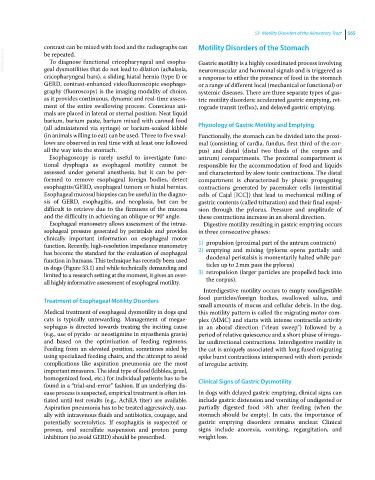Page 597 - Clinical Small Animal Internal Medicine
P. 597
53 Motility Disorders of the Alimentary Tract 565
contrast can be mixed with food and the radiographs can Motility Disorders of the Stomach
VetBooks.ir be repeated. Gastric motility is a highly coordinated process involving
To diagnose functional cricopharyngeal and esopha-
geal dysmotilities that do not lead to dilation (achalasia,
cricopharyngeal bars), a sliding hiatal hernia (type I) or neuromuscular and hormonal signals and is triggered as
a response to either the presence of food in the stomach
GERD, contrast‐enhanced videofluoroscopic esophago- or a range of different local (mechanical or functional) or
graphy (fluoroscopy) is the imaging modality of choice, systemic diseases. There are three separate types of gas-
as it provides continuous, dynamic and real‐time assess- tric motility disorders: accelerated gastric emptying, ret-
ment of the entire swallowing process. Conscious ani- rograde transit (reflux), and delayed gastric emptying.
mals are placed in lateral or sternal position. Neat liquid
barium, barium paste, barium mixed with canned food
(all administered via syringe) or barium‐soaked kibble Physiology of Gastric Motility and Emptying
(in animals willing to eat) can be used. Three to five swal- Functionally, the stomach can be divided into the proxi-
lows are observed in real time with at least one followed mal (consisting of cardia, fundus, first third of the cor-
all the way into the stomach. pus) and distal (distal two thirds of the corpus and
Esophagoscopy is rarely useful to investigate func- antrum) compartments. The proximal compartment is
tional dysphagia as esophageal motility cannot be responsible for the accommodation of food and liquids
assessed under general anesthesia, but it can be per- and characterized by slow tonic contractions. The distal
formed to remove esophageal foreign bodies, detect compartment is characterized by phasic propagating
esophagitis/GERD, esophageal tumors or hiatal hernias. contractions generated by pacemaker cells (interstitial
Esophageal mucosal biopsies can be useful in the diagno- cells of Cajal [ICC]) that lead to mechanical milling of
sis of GERD, esophagitis, and neoplasia, but can be gastric contents (called trituration) and their final expul-
difficult to retrieve due to the firmness of the mucosa sion through the pylorus. Pressure and amplitude of
and the difficulty in achieving an oblique or 90° angle. these contractions increase in an aboral direction.
Esophageal manometry allows assessment of the intrae- Digestive motility resulting in gastric emptying occurs
sophageal pressure generated by peristalsis and provides in three consecutive phases:
clinically important information on esophageal motor
function. Recently, high‐resolution impedance manometry 1) propulsion (proximal part of the antrum contracts)
has become the standard for the evaluation of esophageal 2) emptying and mixing (pylorus opens partially and
function in humans. This technique has recently been used duodenal peristalsis is momentarily halted while par-
in dogs (Figure 53.1) and while technically demanding and ticles up to 2 mm pass the pylorus)
limited to a research setting at the moment, it gives an over- 3) retropulsion (larger particles are propelled back into
all highly informative assessment of esophageal motility. the corpus).
Interdigestive motility occurs to empty nondigestible
Treatment of Esophageal Motility Disorders food particles/foreign bodies, swallowed saliva, and
small amounts of mucus and cellular debris. In the dog,
Medical treatment of esophageal dysmotility in dogs qnd this motility pattern is called the migrating motor com-
cats is typically unrewarding. Management of megae- plex (MMC) and starts with intense contractile activity
sophagus is directed towards treating the inciting cause in an aboral direction (“clean sweep”) followed by a
(e.g., use of pyrido‐ or neostigmine in myasthenia gravis) period of relative quiescence and a short phase of irregu-
and based on the optimization of feeding regimens. lar undirectional contractions. Interdigestive motility in
Feeding from an elevated position, sometimes aided by the cat is uniquely associated with long fused migrating
using specialized feeding chairs, and the attempt to avoid spike burst contractions interspersed with short periods
complications like aspiration pneumonia are the most of irregular activity.
important measures. The ideal type of food (kibbles, gruel,
homogenized food, etc.) for individual patients has to be Clinical Signs of Gastric Dysmotility
found in a “trial‐and‐error” fashion. If an underlying dis-
ease process is suspected, empirical treatment is often ini- In dogs with delayed gastric emptying, clinical signs can
tiated until test results (e.g., AchRA titer) are available. include gastric distension and vomiting of undigested or
Aspiration pneumonia has to be treated aggressively, usu- partially digested food >8 h after feeding (when the
ally with intravenous fluids and antibiotics, coupage, and stomach should be empty). In cats, the importance of
potentially secretolytics. If esophagitis is suspected or gastric emptying disorders remains unclear. Clinical
proven, oral sucralfate suspension and proton pump signs include anorexia, vomiting, regurgitation, and
inhibitors (to avoid GERD) should be prescribed. weight loss.

